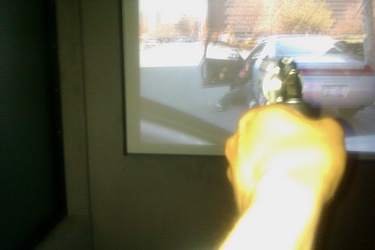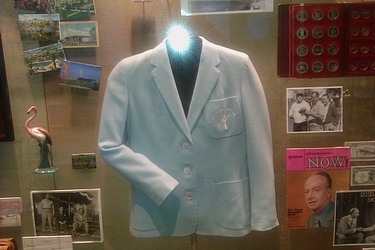Full Motion Video (FMV) Police Lethal Force TrainerIntroduction Recently, out here in Las Vegas, yours truly visited the downtown "Mob Museum", a museum of organized crime and law enforcement. What was really special, and relevant to historic video games, about the museum is that they had an interactive exhibit very similar to the fabled lightgun-driven FBI lethal force simulation trainer. I'd read about the trainer in literature about police and military training, and had wanted to play it for years, but could not imagine a way to have that opportunity other than actually becoming an FBI agent. I was beyond thrilled when all of a sudden, and totally unexpectedly, it was right there for me to use. For years, I had felt envious that people at government agencies got to play all the most realistic video games, games that I could not find in stores no matter how much I would be willing to pay, and I could not at the time imagine anything in the world I wanted to do more than step up and give the simulation a whirl. Description of the Simulation The exhibit consists of a small dark room, a large video screen, and the light gun. The light gun is actually a real handgun that's been modified to act as a light gun. Instead of a chintzy and unrealistic-looking plastic light gun, it was an authentic full sized double action Smith & Wesson stainless .38 +P revolver. As I held the gun I immediately appreciated the weight and serene coolness of the metal as being exactly correct and characteristic of a real firearm. The trigger pull was a long, double action trigger pull, exactly realistic for a double action revolver; and the trigger pull was outstanding, smooth, with exactly the quality and refinement I expect from a Smith and Wesson revolver. The light gun was tethered to the wall with a cable and when not in use was kept in a holster attached to the wall. The first thing I did with this extremely realistic light gun in my hand was almost a reflex reaction to the stimulus of the weight, shape, and coolness of metal in my hand. I kept the muzzle pointed down ahead of me in a safe direction, and I used my right thumb to push on the cylinder release as I flicked my wrist to the left in order to pop out the cylinder. Imagine my delight when I saw that the cylinder swung out exactly like it would in a real revolver, and the casing ejector rod likewise could be manipulated exactly like in a real revolver. The only obvious visual difference at this point between the light gun and a weapon was that there was some kind of obstruction in each hole of the cylinder. Also, due to the heavy tether, while it was possible to open the cylinder, and in fact the game told you to open the cylinder in order to "load" your weapon at the beginning of the simulation, it was not possible to execute an actual tactical revolver reload (demonstrated here, if you're curious), as this maneuver involves switching hands and inverting the revolver. With all this buildup and excitement, in retrospect, it's not really surprising that once the simulation actually started running, I was in for a little bit of a letdown. Of course nothing could be as amazing as the castle I'd been building on a cloud for years. The most succinct way I can characterize the simulation is as one of those old light gun games from the arcade from the 90s that had live action video instead of computer generated graphics. Actors would appear on your screen. If you didn't shoot one of them in time, they would play out a scene that resulted in a game over for you. If you did shoot one of them in time, you would see a little bit of a cut or flicker in the action, like selecting a DVD menu option, the actor would play dead, and the scene would end in your favor. So, it's sort of like Night Trap, but with more killing, yet less controversy. So basically, you have video of a situation in which you confront a suspect, and you have to hold fire until he does something that would make it legal for you to use lethal force against him; normally this would be if he points his firearm at you or someone else, and certainly once he opens fire. At that point, if you fail to hit him within a certain timeframe, the simulation ends because he's presumably ventilated you. If you wound him, the simulation will cut to a sequence where he falls to the ground but keeps firing until you kill him by shooting him some more, or he ventilates you because you didn't expect him to still be attacking you and you failed to react in time. If you score a kill hit during this sequence he slumps dead and the simulation ends. There are two key differences between the simulation available at the Mob Museum and the real FBI trainer. The FBI trainer is able to process verbal commands from the trainee. The FBI trainer also has a gas blowback system on the light gun to simulate recoil. The version of the simulation discussed in this article has neither feature. In the FBI version, you can yell at the suspect (i.e. "DROP THE WEAPON!") and the software will sometimes make the suspect react to what you're yelling. This is important for officer training because obviously when law enforcement personnel hold someone at gunpoint they need to remember to identify themselves as law enforcement officers and be able to give clear, simple, and audible commands to the suspect. However, in the simulation I played at the Mob Museum, the only means of interacting with non-player characters was by shooting them with the light gun. I didn't feel that the lack of a gas blowback system on the Mob Museum's simulation represented any significant loss of realism, the recoil on a .38 Special is extremely soft in the first place. If you've ever fired a .38, even a snub nose, I know that you agree with me. This gentle recoil is a pleasure for target shooting, but there's a reason that virtually no police or military entities use .38 caliber revolvers anymore. Back in the 1930s, according to respected firearms training expert Massad Ayoob, the FBI-issue .38 loaded with 6 unjacketed lead round nose cartridges was known as the "widowmaker" because of its frequent inability to incapacitate bad guys. Perhaps from a historical perspective, though, this type of revolver was suitable for a museum about FBI agents and mafia men. Another consideration affecting the realism of the simulation in the museum is the lack of a wearable holster. In real life, you'd have to draw from a holster, or perhaps from concealment, and fire both quickly and accurately ( http://youtu.be/Ks1lsUQAei8 ), which is considerably more challenging than simply being pointed in on the target and then firing, which requires minimal motor skills and doesn't even take half a second. So for maximum realism, lacking a holster, I decided to keep the revolver pointed in the ground at sul position ( http://youtu.be/ql5KHiUImG8 ) until I was ready to point in at a target. Let's Play! There were five scenarios, randomly selected by the system, and I got to play two. In the first scenario, I got to play the role of an officer in what looked like New York City walking down the block and being approached by a group of citizens stating that around the corner there is a man with a gun. At this point I knew that I was definitely in New York City, because out here in Nevada if someone said, "There's a man with a gun," the cultural response would be a nonchalant, "Pretty sweet! What kind of gun is it?" So, I had the mindset of role-playing an NYPD cop as the video panned around the corner and down the street, and there was a man standing on the sidewalk with his back to me. To his left was the open street, and to his immediate right the brick wall of a store. Directly in front of him was what appeared to be an ice machine, taking up part of the sidewalk. At this point in time, I pointed in at him, and the suspect pivoted around to the left and pointed a handgun at me. As he pivoted to the left, another person became visible standing in front of the ice machine. So part of the challenge of the scenario was not to hit this additional "surprise" bystander. I opened fire. I think I fired three times and hit the armed suspect twice. I was completely embarrassed because one of my shots hit the brick wall, whereas I'd been imagining that I'd just pull off one headshot that would be so rockstar that a disembodied masculine announcer would intone, "HEADSHOT! MONSTER KILL." I was so unhappy that I had missed a shot that before running the sim a second time, I dry fired the revolver several times for practice. A classic double action revolver has a long trigger pull compared to a modern semiautomatic handgun, where the pull is generally short and more crisp. If you're not used to the double action pull you can shoot to the left or right of your mark as your index finger strains with an unexpectedly long motion and jerks the barrel slightly. I also took a few minutes to practice my sight alignment because the classic sights on the revolver are slightly different than on a modern semiauto. Thus feeling a little more confident, I pushed the button to play again and got a second scenario. The second scenario was similar. A citizen approached you and stated that there was a man with a gun in a public park. You go to investigate and the camera pans to an area with a large tree and some handball or tennis courts behind it. At first, the only thing of interest you can see is an arm sticking out from behind the tree. After a moment, a man holding a revolver steps out from behind the tree, but he does not open fire. Instead, he brandishes his weapon, waving it all over the place, while almost studiously not pointing it at you. This continues for a good 20 seconds or so, before he finally does point at you and open fire. The challenge of the scenario is that legally speaking you are not supposed to shoot the armed man until he points in at you and opens fire. So, I covered him the entire time he was brandishing, and when he pointed in, I fired five times and hit him four times. I had a higher volume of shots because he went down but continued firing, so I had to shoot him additional times. I guess my statistical hit rate was better than in the previous scenario, though! Verdict So, all in all, how does the FMV police lethal force trainer rate as a video game? Contrary to my expectations, it's extremely mediocre. It features cheesy actors and tiny sets, as if to represent the epitome of everything that was disappointing about the FMV genre of video games. You might think that an actual police trainer might be hardcore or extremely realistic in some way when it came to using lethal force. But this is not the case. Actors who are "killed" by the player simply drop dead. There is no blood. There is no full body spasming indicative of the nervous system going crazy in response to extreme trauma and shock. There is no blood from the mouth indicative of internal organ trauma. There is no exit wound gore spray. The blood and gore from Call of Freaking Duty is probably more realistic than what you see on the trainer! Surprisingly, death and trauma as portrayed in the trainer is extremely sanitized to the point of being unrealistic. What about realism and gameplay? The focus of each scenario on the simulation is when, legally speaking, to open or hold fire. Compared with most video games this is actually an extremely one-dimensional and simple focus. Unlike the myriad proliferation of high quality tactical shooters which have come out for console and PC, there is no tactical movement or true tactical consideration in the police FMV lethal force trainer. In terms of gameplay, complexity, and strategy, you indisputably get more challenge and realism with regard to tactics from an off-the-shelf hardcore niche tactical shooter. As just one example, SWAT 4 literally has all the legal considerations regarding use of lethal force that the police simulation has in terms of when it is legal or not legal to open fire, but it also has its full suite of tactical squad-level gameplay, a variety of weapons and tools, and complex mission objectives. Much to my amazement, there is simply no comparison in terms of realism and gameplay between the police trainer and hardcore tactical video games, and the video games are actually superior. The only element of the FMV simulation which was excellent was the use of a real revolver as a light gun. I felt that this added a lot more atmosphere and verisimilitude to gameplay on the simulation. As someone who does a lot of shooting sports and who invests a lot of time and energy in training with firearms, I appreciate a shooter game that uses a realistic, heavy gun that requires real-world manipulations to operate. If such a game existed and I owned it, the time I spent on video games would also contribute to my real-world ability with firearms. By holding a realistic and heavy handgun in my outstretched arms for an extended period of time I would build the muscles used in real shooting, and by constantly drilling the movements and manipulations needed for reloads, I would be able to train faster reloads while playing the game. So, the incorporation of a real gun as a controller was one way in which the simulation was far superior to mainstream video games, and is a feature that I wish could be available in commercially available light gun games. On the whole, though, the police FMV training simulation, which for years to me had been a forbidden fruit of video gaming, actually turns out to really, really suck. I used to think that police departments and government agencies had all these great, secret, realistic games only they got to play, but apparently that is not the case. Their games are terrible and the niche tactical stuff you can get commercially is for the most part far superior. |
|||||||||||||||||||
|
|
|||||||||||||||||||
|
|||||||||||||||||||
|
|
|||||||||||||||||||

|

|
|||||||||||||||||||||||||||||||||||||||||||||||||||||||||||||||||||||||||||||||||||||||||||||||||||||||||||||||||||||||||||||||||||||||||||||||||||||||||||||||||||||||||||||||||||||||||
|
|
|||||||||||||||||||||||||||||||||||||||||||||||||||||||||||||||||||||||||||||||||||||||||||||||||||||||||||||||||||||||||||||||||||||||||||||||||||||||||||||||||||||||||||||||||||||||||
| © 2025 ParryGamePreserve |





















